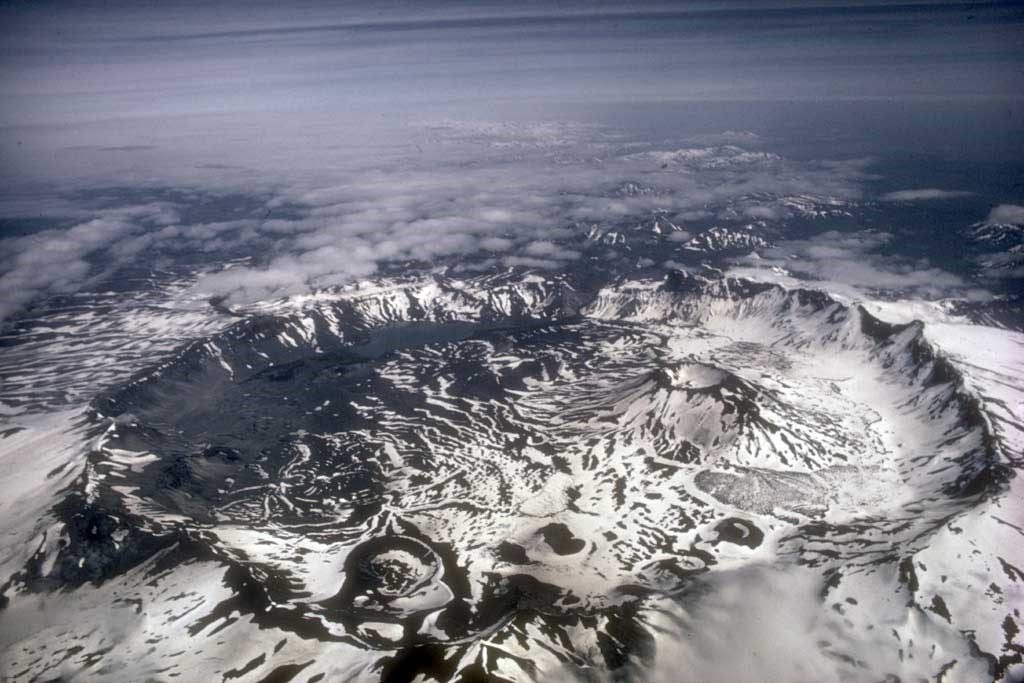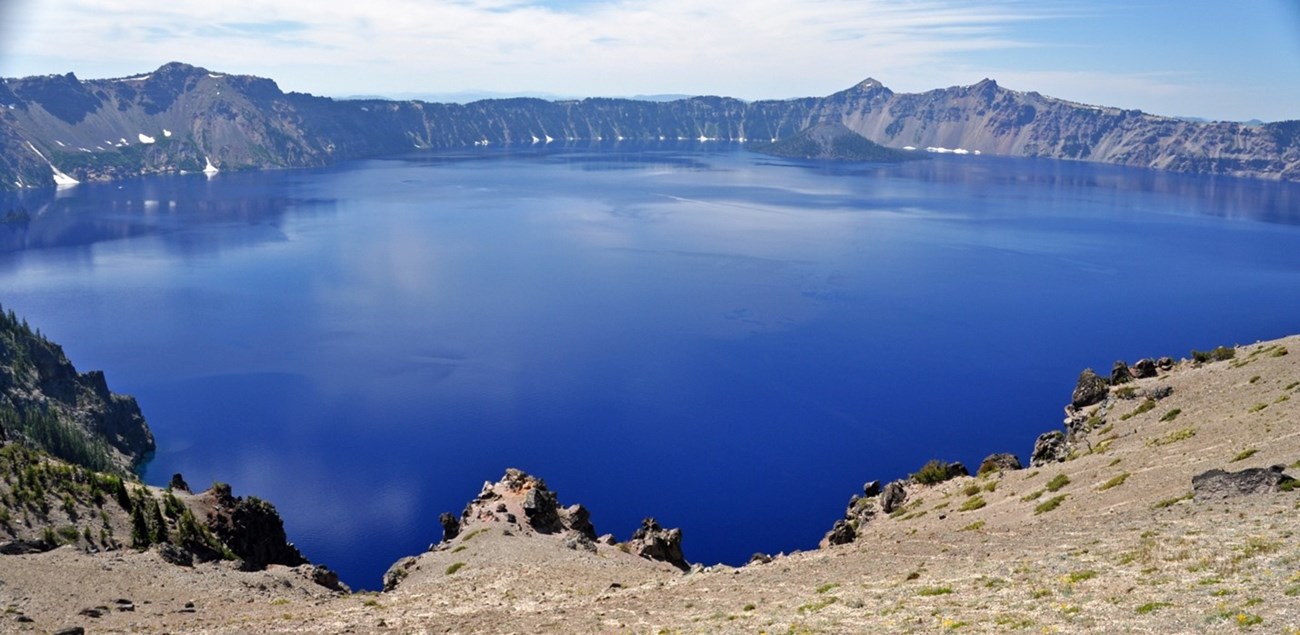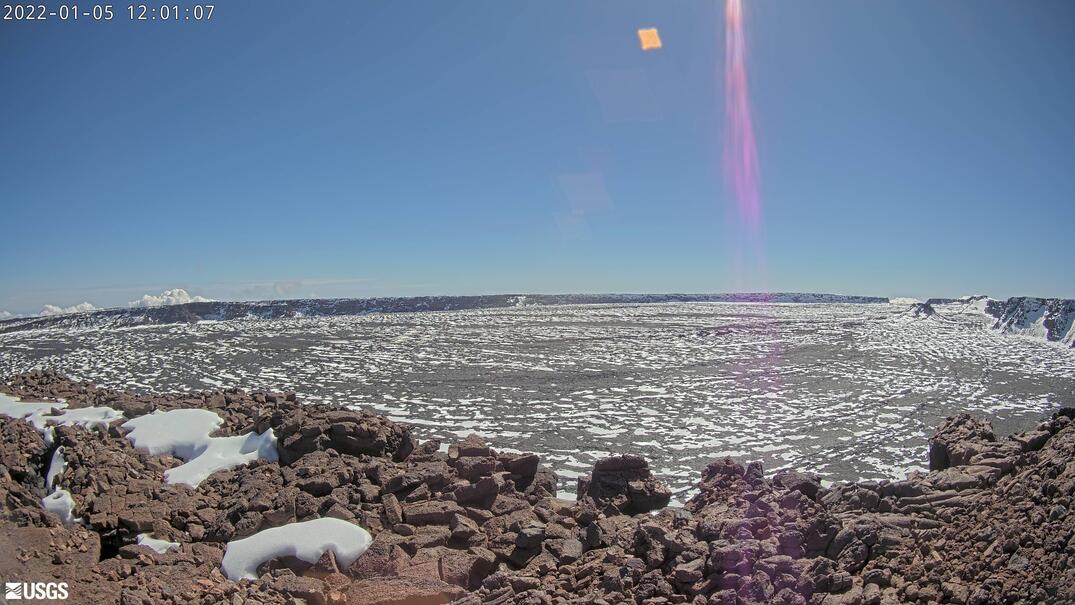Part of a series of articles titled Volcano Types.
Previous: Shield Volcanoes
Next: Explosive Calderas
Article

NPS photo by M. William.
Calderas are collapse features that form during large-volume volcanic eruptions when the underlying magma chamber is partially emptied and the ground above it subsides into it. Calderas may form in both silicic (dacitic to rhyolitic) and mafic (basaltic to andesitic) volcanic systems, leading to two main types of calderas. In addition to the composition of magma erupted, these calderas are also differentiated on the basis of whether the eruptions that produced them were effusive (nonexplosive) or explosive.
Explosive calderas form during eruptions of silicic magmas that emit large-volume ash-flow tuffs and form Ultra-Plinian eruptive columns.
Nonexplosive calderas form on the summit of shield volcanoes during especially large eruptions of lava flows at either the summit or along flank rift zones.
Calderas are large, generally with a diameter greater than 0.6 miles (1 km). The largest calderas are tens of miles (kms) wide. A defining characteristic of calderas is that they have diameters that are much wider than their included vents.
Calderas are both landforms that are parts of other volcanoes and a type of volcano in their own right. Resurgent calderas, the largest type of caldera, are not associated with any individual volcanic edifice, but are characterized by broad volcanic plateaus with voluminous ash-fall and pyroclastic-flow deposits (ignimbrites).
Calderas are excavational (or inverse) volcanoes with relief below the general land surface because they form from subsidence (or foundering) of the surface. In this way, they are the opposite of constructional volcanoes like cinder cones, composite volcanoes, and shield volcanoes that form from the accumulation of lava and tephra.

John St. James photo.
Explosive calderas result from violent eruptions of great quantities of silicic magmas. These eruptions produce massive eruption columns that extend into the stratosphere and voluminous pyroclastic flows. Eruptions that produce explosive calderas generally range from 6 (Colossal) on the Volcanic Explosivity Index (VEI) to 8 (Apocalyptic) super eruptions.
The different types of explosive calderas vary in size, eruption magnitude, diameter, age, and whether they formed at summit of a preexisting volcano.

USGS photo, Hawaiian Volcano Observatory.
Nonexplosive calderas are located at the summit of most large shield volcanoes, like Kīlauea and Mauna Loa in Hawai’i Volcanoes National Park. They form during VEI 0-1 (Effusive to Severe) eruptions that drain the shallow magma chambers located beneath them. Nonexplosive calderas can contain pit craters, which are smaller collapse structures, as well as lava lakes that can be active for periods of time.
Shield volcanoes can experience several cycles of caldera collapse and subsequent infilling by lava flows.
| Park | Caldera Type | Composition | Age | Primary Significance | In Park |
|---|
Aniakchak National Monument (ANIA), Alaska—[ANIA Geodiversity Atlas] [ANIA Park Home] [ANIA npshistory.com]
Bandelier National Monument (BAND), New Mexico—[BAND Geodiversity Atlas] [BAND Park Home] [BAND npshistory.com]
Bering Land Bridge National Preserve (BELA), Alaska—[BELA Geodiversity Atlas] [BELA Park Home] [BELA npshistory.com]
Big Bend National Park (BIBE), Texas—[BIBE Geodiversity Atlas] [BIBE Park Home] [BIBE npshistory.com]
Channel Islands National Park (CHIS), California—[CHIS Geodiversity Atlas] [CHIS Park Home] [CHIS npshistory.com]
Chiricahua National Monument (CHIR), Arizona—[CHIR Geodiversity Atlas] [CHIR Park Home] [CHIR npshistory.com]
Coronado National Monument (CORO), Arizona—[CORO Geodiversity Atlas] [CORO Park Home] [CORO npshistory.com]
Crater Lake National Park (CRLA), Oregon—[CRLA Geodiversity Atlas] [CRLA Park Home] [CRLA npshistory.com]
Gila Cliff Dwellings National Monument (GICL), New Mexico—[GICL Geodiversity Atlas] [GICL Park Home] [GICL npshistory.com]
Hawai’i Volcanoes National Park (HAVO), Hawai’i—[HAVO Geodiversity Atlas] [HAVO Park Home] [HAVO npshistory.com]
Katmai National Park (KATM), Alaska—[KATM Geodiversity Atlas] [KATM Park Home] [KATM npshistory.com]
National Park of American Samoa (NPSA), American Samoa—[NPSA Geodiversity Atlas] [NPSA Park Home] [NPSA npshistory.com]
Saguaro National Park (SAGU), Arizona—[SAGU Geodiversity Atlas] [SAGU Park Home] [SAGU npshistory.com]
Valles Caldera National Preserve (VALL), New Mexico—[VALL Geodiversity Atlas] [VALL Park Home] [VALL npshistory.com]
Wrangell-St. Elias National Park and Preserve (WRST), Alaska—[WRST Geodiversity Atlas] [WRST Park Home] [WRST npshistory.com]
Yellowstone National Park (YELL), Wyoming—[YELL Geodiversity Atlas] [YELL Park Home] [YELL npshistory.com]
Part of a series of articles titled Volcano Types.
Previous: Shield Volcanoes
Next: Explosive Calderas
Last updated: April 17, 2023